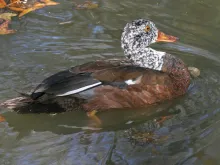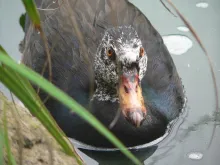
White-winged wood duck (Cairina scutulata)
Species name
- Dutch name:
- Witvleugelboseend
- English name:
- white-winged wood duck
- German name:
- Weißflügel ente
- French name:
- Canard à ailes blanches
- Scientific name:
- Cairina scutulata
Scientific classification
- Order:
- Anseriformes
- Family:
- Anatidae
- Onderfamilie:
- Cairininae
- Genus:
- Cairina
Description
- Description:
Male:
Head and most of neck white, very variably freckled dark grey, from very heavily, appearing quite dark at a distance, to almost completely white and with white extending down onto the breast and even upper belly. Majority of the birds are well freckled with black feathers that shine forest green iridescents contrasting with the pale whitish head and upper neck. Gets more specked towards the belly. Lower neck, breast and upper belly, dark brown to black; lower belly, flanks, vent and undertail-converts dark chestnut brown. Upperparts, including uppertail converts and tail, blackish-brown with glossy green iridescence .On upperwing, primaries and primary converts dark brown black, secondaries bluish grey, forming speculum, with white forewing; tertails black, with white outermost feathers; underwing with white converts and black flight feathers. Bill yellow-orange, becoming redder in breeding season, when slightly swollen at base. Legs and feet yellowish–orange.Female:
Females are smaller and usually have head and upper neck. Head more densely mottled speckled and most of neck, very variably freckled dark grey, from very heavily, appearing quite dark at a distance. Majority of the birds are well freckled with black feathers that shine forest green iridescents. Gets more specked towards the belly. Lower neck, breast and upper belly, dark brown to black.; lower belly, flanks, vent and undertail converts dark chestnut brown. Upper parts, including upper tail converts and tail, blackish-brown with glossy green iridescence. On upperwing, primaries and primary converts dark brown black, secondaries bluish grey, forming speculum, with white forewing; ter tails black, with white outermost feathers; underwing with white converts and black flight feathers. Bill yellow-orange. Legs and feet yellowish –orange.Juvenile:
A juvenile is duller and browner. usually have more densely mottled speckled head and upper neck.
Standard Measurements
- Body Length (cm):
- The male (drake) of the White-winged wood duck measures approximately 66-81 centimeters. The female measures approximately 66-81 centimeters.
- Body Weight (grams):
- The male will weight about 1860-2680 gram. The female will weight about 1860-2680 gram.
The weight is notoriously variable and can only be used as indication!
- Note:
The White-winged Duck usually nests in tree holes, forks and hollows. The female incubates overnight, while the male roosts nearby and approaches at dawn to escort he to foraging grounds for the first few hours of the day; he then accompanies her back to the nest and returns to his roost until late afternoon, when he again visits and accompanies her on a foraging trip, the birds returning to their original positions for the night towards dusk. When the male returns to the nest with the female (i.e. late morning and dusk) he perches in the nest tree for a while or flies about nearby until she is settled, a behaviour which helps in the detection of nests.
- Breeding:
- The female White-winged wood duck usually lays from 8-16 eggs and incubates them for 33 days.
- Artificial incubating:
The ideal relative humidity for incubating most waterfowl eggs is 55% (ground nesters) and 40% (cavity nesters). The temperature is usually 37.4°C. Set ventilation as recommended by the incubator manufacturer. Eggs must be turned, either automatically or by hand, a minimum of 4 times a day. As the duckling develops there is a loss of water from the egg and the air sac gets bigger. In normal development of an egg with a 33 days incubation, the air sac occupies about a third of it three days earlier. Cleanliness is vital and ideally eggs should be moved to a separate hatcher at this point, where the humidity should be increased to 65% and even higher once they have pipped internally.
- Bird banding:
- Recommended closed leg band ring size for the White-winged wood duck is 16♂︎/14♀︎ mm.The leg band ring can only be applied on a young large duck at around 12-14 days old.
- It doesn't matter what leg that you band, but it's good to have a consistent system. Suggested: Left leg = Female, Right leg = Male
- Rearingfeed:
-
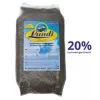
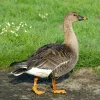

Floatable special rearing feed for all types of aquatic ornamental fowl - especially for the cultivation of trees as well as greening ducks.
This well-balanced complete feed with 20% protein content convinces above all by its good compatibility and forms the basis for visibly healthy growth from day one.
Made exclusively from wholesome and selected raw materials, Lundi Micro Regular is also ideally suited for the year-round feeding of waterfowl.
- Maintenance food:
-



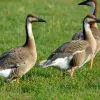

Lundi Regular with a protein content of 20%, valuable Spirulina and high-quality by-products is optimally balanced in its composition maintenance food for water ornamental fowl of all kinds. Especially green teal and Whistling ducks that are not dependent on a very high protein content, are well supplied.
Lundi Regular contains all the minerals and vitamins in full form that are important for the animals. Therefore also suitable as breeding food.


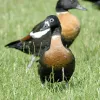


Floating full food for all sea ducks, green ducks, eider ducks and geese, especially in the moulting and breeding phase ideally suited. Packed with wholesome raw materials, natural vitamins and trace elements, this performance food with a protein content of 30% forms the basis for lifelong vitality.
- Regulation:
- CITES bijlage A
- Regulation:
Deze soorten dienen altijd vergezeld te gaan van een CITES-document. Hierop staat o.a. de geboortedatum, de soortnaam, het geslacht en andere informatie zoals het ringnummer en de diameter van de ring die relevant zijn om het dier te identificeren. Dit internationale paspoort moet altijd bij het dier blijven, waar het ook heengaat.Houders van CITES A soorten dienen een register(boekhouding) bij te houden waarin men o.a. noteert het nummer van het CITES-document, soortnaam, de datum van aankoop en eventuele latere verkoop, verkregen jonge dieren en de datum van overlijden. Een voorbeeld van dit register is te downloaden via www.cites.org.Bij het verkrijgen van nakweek uit CITES A vogels dienen deze geringd te worden met een erkende, geregistreerde ring met een vaststaande diameter. Zolang de nakweek vogels in uw bezit blijven, op het adres dat gelijk is aan dat waar de oudervogels zich bevinden, is een CITES-document voor hen nog niet noodzakelijk.Zodra u de nakweek wilt overdoen aan een andere eigenaar dient u voor de vogels een CITES document aan te vragen. Dit gaat op basis van de CITES documenten van de beide oudervogels. Als de CITES-documenten in uw bezit zijn mag de nakweek uw adres verlaten, NIET eerder! In uw registratie noteert u dan waar de betrokken dieren heengaan.

